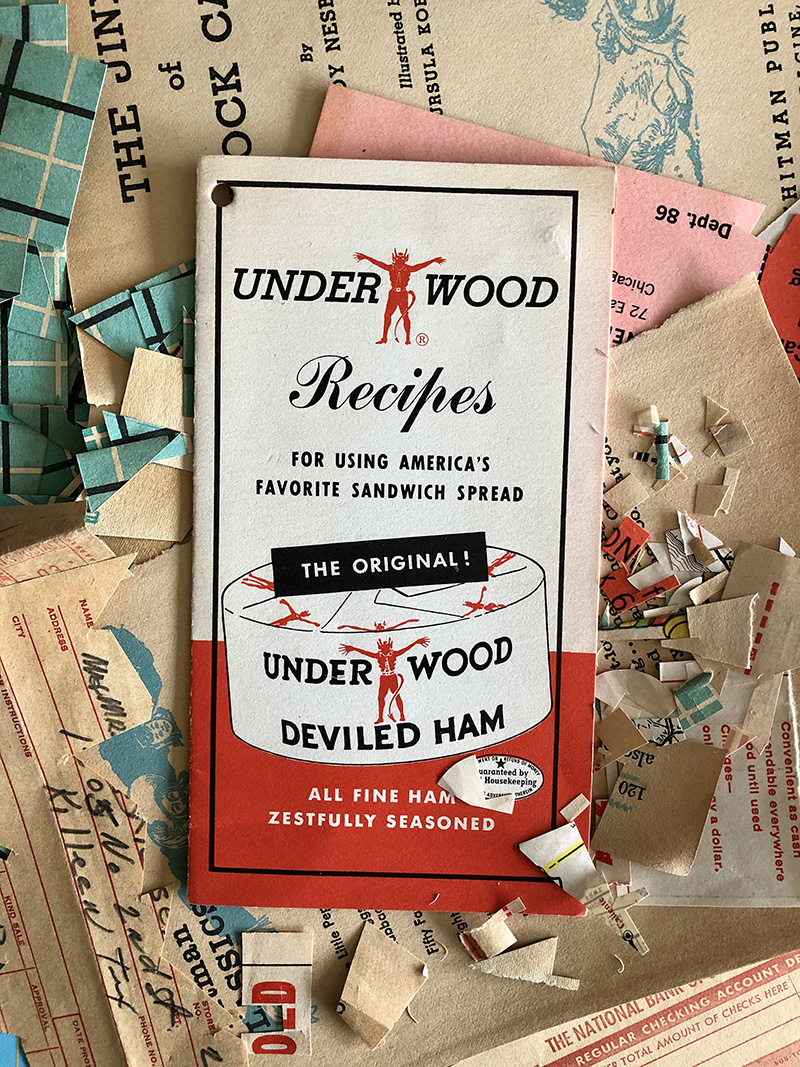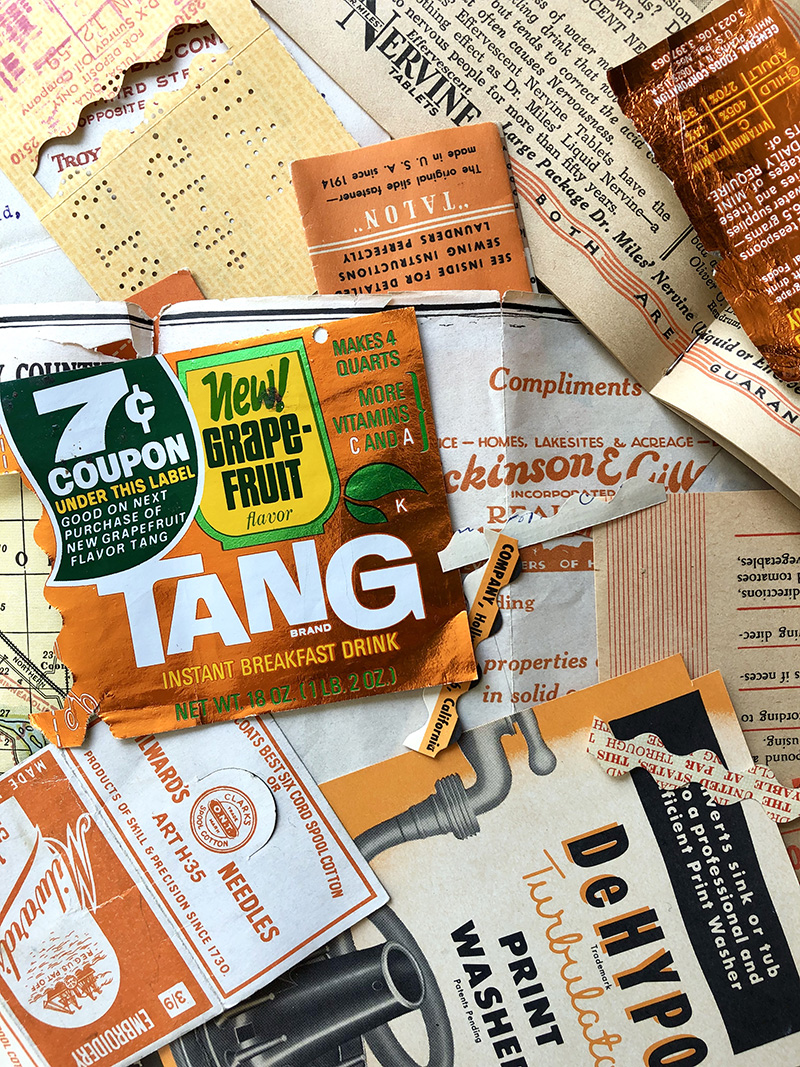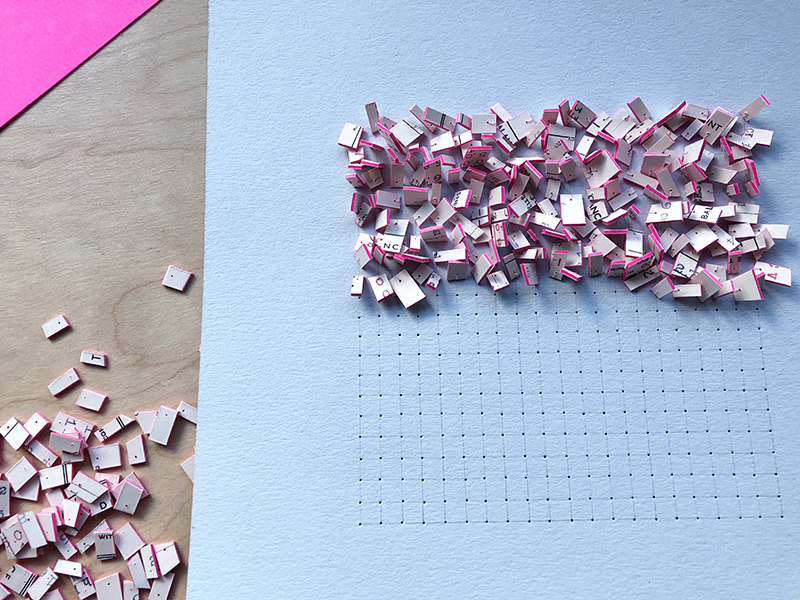Contemporary artist Nell Nordlie enjoys the possibilities of chance and improvisation, using ephemera to tell her story.
Within the context of art history, I want to challenge the idea that craft is inferior to “fine” art. I also hope that the small scale of my work encourages viewers to slow down, get close to it, and see details that might otherwise be overlooked.

Contemporary artist Nell Nordlie. Photo by KT Langley.
Take us to the beginning of your story. How did your relationship with art begin?
I was raised in Sioux Falls, South Dakota, in a family of makers and teachers. My respect for craft and ingenuity developed as I saw relatives thoughtfully exploring and shaping their environment by building furniture, pipe organs, model railway villages, and houses; designing, sewing, knitting, crocheting, and altering garments and textiles; repairing motorcycles and machinery; tending to gardens and workshops; and experimenting with materials, tools, and recipes.
Additionally, growing up alongside a younger brother with a disability introduced me to the idea that people contribute to their communities in many different ways. Knowing that he would not follow a common trajectory in life led me to place value upon human interaction, empathy, and introspection above traditional ideas of productivity or accomplishment. Making art was a solitary process where I had control; I could create a space that I was proud of while escaping some of life’s uncertainty.

Contemporary artist Nell Nordlie
Tell us about the evolution of your process and practice over the years.
Detailed, repetitive mark-making and bright colours have always been important elements in my work. I used to paint thousands of dots and circles on ceramic dishes, walls, and paper boxes. Polymer clay was my preferred dimensional material for a long time — I made tiny balls to fill a variety of clear vessels and sewed little sculpted objects onto canvases.
I decorated cakes, strung lots of beads, cut notable content out of magazines, embellished clothes, and drew patterns on whatever surfaces were lacking ornament.
While studying studio art at Macalester College in St. Paul, Minnesota, I discovered how little joy I felt when making representational work. There was an emphasis on traditional methods and subjects in some of my classes, but I was also encouraged to experiment with materials along the way. I found that paper was a relatively inexpensive and versatile medium. My ephemera collection was much smaller at that time, but I did cut up a lot of my grandparents’ cancelled checks for my thesis installation! I started making flat and sculptural collages using vintage photographs, books, paper, and packaging in 2015 and continue to think of variations that I’m excited to play around with.
At this stage in my practice, I’m more interested in chance and improvisation than in control and perfection. I have gotten to a place where my art is less about making an idea in my head and more about generation through the physical creative process. I have a box filled with scraps from various projects; looking at the array of colourful, imperfect shapes is often a good starting point if I’m trying to work in a more instinctive way. Because I’m not relying on regular income from my studio practice, I’m able to experiment freely without being concerned about constant production. I do hope to dedicate more time to art in the near future, but I want to maintain the curiosity that makes the tedium enjoyable.

Contemporary artist Nell Nordlie
Take us through your frameworks of reference.
I’m eager to learn about a variety of processes – quilting, clothing fabrication, and risograph printing have been on my mind a lot lately – and I continue to think about different ways that I can use the ephemera that I have collected or incorporate other materials into my practice. My main motivation when making art is to create a thing that excites me and leads to more questions.

Contemporary artist Nell Nordlie
What is the primary role of an artist? How do you describe yourself in the context of challenging people’s perspectives via your work and art?
Artists don’t have a primary role in the way that many other professionals do – the lack of prescribed outcomes opens up the field to immense possibility. While artists’ motivations and processes differ greatly, they express actions and ideas in a visual way. More specifically, I admire artists who are careful observers and researchers; they synthesise intuition and information into nuanced work that acts as a record of their lived experience.
Within the context of art history, I want to challenge the idea that craft is inferior to “fine” art. I also hope that the small scale of my work encourages viewers to slow down, get close to it, and see details that might otherwise be overlooked.

Contemporary artist Nell Nordlie
How do you balance art and life?
My studio practice is intentionally isolating – I really enjoy time alone, and I’m most productive without company. I often look at other artists’ work alone, too, as it’s difficult to anticipate how long I’ll want to spend in any particular place. I’m prone to rushing past work that I’m not immediately drawn to. There’s a lot of art to see and I want to trust my instincts. I love to talk to artists about their work if I have had a chance to engage with it for a while.
To further fulfill my want for meaningful relationships, I nanny full time and volunteer with several art, design, and youth-focussed organisations in Seattle; Museum of Museums (MoM), Sawhorse Revolution, and Big Brothers Big Sisters meet a variety of needs in the community, and their focus on education and collaboration resonates with me. I also design catalogues for exhibits at the Law Warschaw Gallery in St. Paul, and enjoy the process of working with artists, writers, and curators.
While I do feel like making art and fostering community are often separate priorities in my life, I find that observation, care, and play inform both roles greatly.

Contemporary artist Nell Nordlie. Artist in studio.
How do you deal with the conceptual difficulty and uncertainty of creating work?
The vintage ephemera that I use are fragile – certain colours are prone to fading, paper tears and warps easily, and preservation is a real challenge. Even when framed and covered with glass that protects it from most UV rays, my work can discolour rapidly if it’s displayed in an area with a lot of direct, natural light. I was disheartened when some vibrant pink invoices from the early 1900s faded on my desk, but I tried to work with that change and decided to experiment with some intentional sun bleaching.
Ultimately, I think detailed works on paper can be more fully seen and appreciated when they aren’t covered with glass or plexi. Reflections and glare change the viewing process drastically, but I understand the desire to protect work. Conceptually, ephemera lend itself to less refined presentation. Receipts from a century ago were never meant to last this long, and it’s futile to hope they’ll stay crisp and bright for another hundred years unless they’re carefully stored out of view. I’m still figuring out what to do when long-term preservation and immediate appreciation are at odds with one another.
Because I often work with irreplaceable materials, I am prone to hesitation during the process, but I constantly remind myself that experimentation leads to valuable outcomes. Certainty used to be the reason that I created; I could anticipate and control outcomes. I’m now bored by predictable resolutions and continue to welcome chance into my practice.

Contemporary artist Nell Nordlie
What are you looking for when you look at other artists’ work? Who are your maestros?
I’m drawn to work that I have to figure out. I like to revisit pieces and see details and ideas emerge over time. I love colour, and I have a lot of respect for artists who use processes and materials that articulate a concept well. Grids and systems are a source of comfort, but playful or bold representational work also excites me.
Sol LeWitt’s wall drawings, Louise Bourgeois’ fabric book Ode à l’Oubli, and the quilts of Gee’s Bend are some works that have influenced me greatly. I have also enjoyed studying Yayoi Kusama, Eva Hesse, and Henri Matisse and admire their tenacity.
I make an effort to see as much art as I can in Seattle and Portland, and I try to check out museums and galleries in other cities when I get the chance. The work of these artists has been a point of reference in 2019: Emily Counts, Jeffrey Gibson, Dan Gluibizzi, Damien Hoar de Galvan, Ellen Lesperance, Evan Nesbit, Joe Rudko, Brian Sanchez, Tschabalala Self, and Chelsea Ryoko Wong.

Contemporary artist Nell Nordlie
What are you working on now? What’s coming next season?
I’m working on a couple of commissions at the moment. They’re both paper collages, but one has a regular hexagonal pattern and the other is more like an improvisational quilt. Much of my recent research has focused on quilts, and I’m especially interested in examples that are irregular in pattern or shape. Two of my favorite books on the subject are Unconventional & Unexpected: American Quilts Below the Radar 1950–2000 by Roderick Kiracofe and Gee’s Bend: The Women and Their Quilts published by Tinwood Books. I’m drawn to the sculptural and utilitarian properties of quilts, and appreciate their ties to community and resourcefulness.
Feed sacks are the fabric equivalent to the paper ephemera that I use. They combine colour, typography, and bold design in a really beautiful way. I’m excited to start working on a quilt made from less-than-perfect vintage materials – the history and expressive visual texture of found paper and fabric is something I’ll be fixated on for a long time.
Before you go – you might like to browse our Artist Interviews. Interviews of artists and outliers on how to be an artist. Contemporary artists on the source of their creative inspiration.












Add Comment